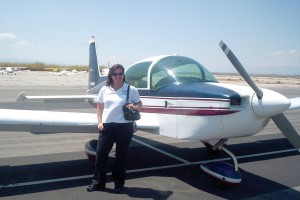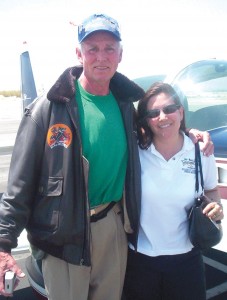By Fred “Crash” Blechman
This is a story about a flight with two tigers. The first tiger is an airplane—a Gulfstream American AA-5B “Tiger.” The other “tiger” is a woman that the expression, “Go get ’em, Tiger!” could describe. Her name is Anne Marie Radel—but I have given her a “call sign,” and she’s now known as Anne Marie “Tiger” Radel! Why? Read on.

Anne Marie Radel flies her 1979 Gulfstream American AA-5B Tiger cross-country, as well as locally, from Whiteman Airport.
“Tiger” Radel made me an offer I couldn’t refuse: “Why don’t we go flying in my Tiger sometime? We could go anywhere you like around Southern California.”
I immediately accepted. How could I resist flying with an attractive woman who owned her own plane and was brave enough to fly with a guy whose call sign is “Crash”? Not only that, but I had never been to Fox Field, and I wanted to do a story about a flight there.
My good friend, Lee “Stretch” Auger, drove us to Whiteman Airport in Pacoima. We met Tiger at Rocky’s Restaurant on a very hazy Sunday afternoon. She had just come down from an instrument training flight in her Tiger, since she is now aiming for her instrument and commercial licenses.
We went out to her aircraft, and I was impressed by its sleek appearance and great paint job. Looking like it had just come off the production line, inside and out, this airplane was actually built in 1979, and she has owned it—and updated it—since July 2005. With a fixed-pitch Sensenich propeller replacing the original that had an rpm restriction, this 180-hp, four-place, low-wing beauty could cruise at 120 mph using only 9.2 gallons of fuel per hour. With a full-size, rear-sliding canopy, it was extremely easy to enter, even for Stretch—who pretty much took up both back seats! (Incidentally, I have a motto for the propeller maker: “If you’re unhappy with your propeller and “sense an itch,” scratch it with a Sensenich!”)
Let me continue with our flight to Fox Field, the common expression for its proper name, General William J. Fox Airfield. It’s located in the city of Lancaster, Calif. No bird with any common sense would fly directly from Whiteman Airport to Fox Field—especially with the heavy haze we had that afternoon—since some mountain peaks along the direct route are more than 5,000 feet. So Tiger did the smart thing—we followed roads, which tend to go between high mountains, for much of the flight.

Anne Marie Radel bought her 1979 Gulfstream American AA-5B Tiger in July 2005, updated it and flies it often.
Anne Marie fed her Tiger, N28983, with fuel, and we were off the ground at 70 mph from Whiteman’s Runway 12 at 12:50 p.m. Climbing at 95 mph and 800 feet a minute, we turned left toward the Newhall Pass on a heading of 300 degrees, climbing to 4,500 feet. It was very hazy, with visibility not much above three miles, but we found the pass easily by following above the Golden State Freeway to where it branched off to the right and became the Antelope Valley Freeway.
I took the controls while Tiger reset her GPS, even though we weren’t going to fly direct to Fox Field. I picked up a heading of 40 degrees while climbing to 5,500 feet, taking us over Agua Dulce Airport, as the mountains on the southern border of the Antelope Valley came into view. Cruising at an indicated 115 mph, I flew through a notch in the mountains and turned north, descending toward where Fox Field should be. Although there was still haze directly ahead of us, we could easily see Palmdale Airport to our right. We flew over the California State Prison as Fox Field came into view three miles ahead—just as the GPS showed it should.
Fox Field is in the high desert, with a runway altitude of 2,350 feet. Tiger took over, entered the pattern at 3,150 feet, and landed on 7,200-foot Runway 24 at 1:20, a half-hour flight. We flew about 50 miles for an average speed of about 100 mph—not bad considering that we had climbed to 5,500 feet a good part of the way.

Lee “Stretch” Auger, who took up both rear seats, thanked Anne Marie “Tiger” Radel for the flight just before we returned from General William J. Fox Airfield to Whiteman Airport.
Anne Marie tied down the Tiger and we walked over to the nearby administration building. I was curious about the history of Fox Field, and found “Keech,” an old-timer, at the airport. He said it was named after retired General William J. Fox, an airport commissioner at the time the airport opened in 1960. It has a control tower, and although there’s no commercial service at the field, there are more than 200 aircraft based there, and an average of almost 250 aircraft operations a day. It’s a favorite place for pilots to practice cross-wind landings—especially in the afternoons when the winds kick up, sometimes not directly down the single runway. During the Southern California fire season, the Forest Service bases fire tankers there.
We passed by the gift shop, which carries a lot of flying books, and into Foxy’s Landings Restaurant, which is open from 7 a.m. to 4 p.m. seven days a week (the large menu, with very reasonable prices, can be found at www.foxfield.com/information.htm). The food and service were good, and the décor includes many airplane models. It’s also where I found out more about Anne Marie Radel—and why I gave her the call sign Tiger.
She was born in Midland, Texas. Her father was in the oil business, and she moved to Lima, Peru, for three years when she was young, went to school there, and learned to speak fluent Spanish. She finished high school in Houston. She went to the High School for Performing and Visual Arts, and was a drama major. Later, she moved out to California to continue being in the entertainment business—”singer, vocalist, studio singer—anything and everything.”
“I did a lot of country demos and commercials,” she said. “I’ve done pop ballads for soap operas and I’ve sung for the Emmy awards.”
In fact, she has a song publishing company and writes songs. As for her singing, I’ve heard a CD demo, and she’s good!
There’s so much more. I have three pages, single spaced, of notes on what Tiger has done—and how she feared flying for more than 20 years.
“I was doing a show in Mexico City, and the morning when I was at the airport, preparing to leave, I saw a Western Airlines commercial airliner crash,” she explained. “Everyone perished. That made me never want to fly again.”
Many in her family were pilots, and she was completely aviation-friendly prior to this accident, and had flown in light planes frequently with friends and relatives since she was 15 years old.
“I just loved it. It was so free,” she reflected.
She became a white-knuckle flyer when she had to go on flights to entertain. But things changed when one of her brothers, a general aviation commercial pilot, pointed out that she had a control issue, and a fear of dying at someone else’s hand.
“You need to understand aerodynamics, and understand that these planes really want to keep flying he told her,” he told her. “You should take some ground school and just get over your fear.”
So the “pussycat” became a tiger. She took a 10-week course (three hours one night a week) at Pierce College learning aerodynamics. Her feeling was, “I get it.”
“Intellectually, I understand how these things fly,” she said.
She had conquered her fear. She took an introductory lesson at the Van Nuys Flight Center, learned to fly at Van Nuys Airport at Continental Flight Services, got her private pilot’s license, and then raced in the Air Race Classic and has gone on a lot of treasure hunts.
Tired of renting different planes, Anne Marie flew a Tiger, and liked its simplicity and great visibility. So, at the end of July, last year, she bought one with her husband of 25 years, Mike, as a partner—although he isn’t a pilot.
“He has taken lessons in it,” she adds. “He’s a great passenger. He’s very aviation-friendly.”
Our flight back to Whiteman took less than 30 minutes. The visibility, though improved, was still hazy. I had the controls most of the way back flying at 6,500 feet and had to make a descending 360 when we neared the Newhall Pass to get down to 3,500 feet. Tiger landed smoothly on Runway 12 to end a really fun flight.
Anne Marie is a member of the San Fernando Valley Chapter of the Ninety-Nines, as well as the Latin-American Pilots Association. She has one stepson and a 23-year-old daughter who just graduated from the University of California at Santa Barbara. In addition to being an ASCAP writer, she has her own ASCAP music publishing business. Also, she and Mike together have a business called “Safer Baby,” to protect babies from accidents by “baby-proofing” the home. Go get ’em, Tiger!
Fred “Crash” Blechman’s two flying books, “Bent Wings—F4U Action & Accidents: True Tales of Trial & Terror!” and “Flying With the Fred Baron,” are available at [http://www.amazon.com] or [http://www.bn/com].











